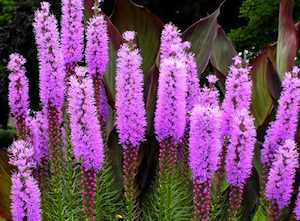By Sean Conway

The purple flowers of Liatris attract butterflies and other winged insects
More and more people are introducing native wildflowers into their home landscape, drawn no doubt to the romantic looseness and attractive color they add to garden plantings. But native plants have further benefits: They increase biodiversity in the garden, attracting wildlife, and they are often better suited to climactic variances such as lack of rainfall or extremes in temperatures than non-native garden plants.
When it comes to buying wildflowers, many gardeners are unsure of themselves. A common question asked of nursery professionals is, "Is this a weed or a good plant?" Many shoppers don't realize that there is no botanical definition for "weed." What they fear is that a "wild" plant will grow too aggressively. This is where a little research comes in handy. Some wildflowers will behave in your garden, forming manageable clumps, while others run rampant through flowerbeds and therefore are better used in other parts of the landscape. The trick is finding the right plant for the right location. And, of course, different plants can be native in different parts of the country.
In my own garden I converted a large area of lawn into a wildflower meadow. I carefully selected which perennial wildflowers to plant into the meadow. I chose plants that grew tall so they would show up above some of the taller grasses and ones that would provide a long season of color. I also chose a few aggressive types so they would not be choked out by the rapid growth of spring grass. The result has been fantastic, and the wildflowers are the stars of the meadow. They add color and drama all season long without looking contrived.
Here are a few choice perennial wildflowers that you might consider including in your garden.
Milkweed (Asclepias incarnata)
Sweet smelling and perfect for either a perennial border or a meadow, it is a host plant for monarch butterflies.
Sneezeweed (Helenium autumnale)
This meadow beauty has coppery colored flowers in mid to late summer. Don't worry, it won't make you sneeze.
Goldenrod (Solidago sphacelata)
Contrary to popular belief, the pollen of goldenrod doesn't produce an allergic reaction. These plants are not only beautiful but reliable and easy to grow. They provide nectar for multitudes of insects, and the plant also plays host to a variety of butterfly larvae.
Black-eyed Susan (Rudbeckia fulgida)
Commonly seen along roadsides, it grows in a variety of soils, is drought tolerant, and blooms for weeks at a time.
Culver's root (Veronicastrum virginicum)
These elegant plants have elongated, wand-like flowers. They will grow in full sun or dappled shade and attract a variety of native butterflies.
Great coneflower (Rudbeckia maxima)
This bold-leafed, tall rudbeckia has blue-grey foliage that is attractive in its own right. However, it is the 6- to 8-foot-tall stems with giant black-eyed Susan type flowers at the ends that really make this plant a stand out.
False sunflower and/or oxeye (Heliopsis helianthoides)
This lovely plant produces 6-foot-tall yellow. Disk-like flowers on sturdy stems and grows with an open habit. The stems are a beautiful dark purple.
Gaura
Gaura lindheimeri is a native of Texas, Louisiana and Mexico, but 'Siskiyou Pink,' a vivid pink variety, was discovered as a genetic sport at
Blazing Star (Liatris
The sturdy wand-like purple flowers of L. spicata are a favorite food source for many species of butterflies as well as other small winged insects.
Thanks to the growing popularity of native wildflowers, more garden centers are stocking these beautiful plants or their cultivars. You can also look for them at the local native plant sales popping up across the country. A great variety of seeds are available from the many online sources that specialize in native gardening.
If attracting more wildlife to your garden interests you, why not plant a few well-chosen wildflowers in your yard. You will be amazed at their sturdiness and carefree beauty.
Available at Amazon.com:
Trowel and Error: Over 700 Tips, Remedies and Shortcuts for the Gardener
Cut Your Energy Bills Now: 150 Smart Ways to Save Money & Make Your Home More Comfortable & Green
It's Easy Being Green: A Handbook for Earth-Friendly Living
Copyright © Cultivating Life by Sean Conway. All rights reserved.
AUTOS | HOBBIES | EDUCATION | FAMILY | FASHION | FOOD & RECIPES | HOME DECOR | RELATIONSHIPS | PARENTING | PETS | TRAVEL | WOMEN
Home & Garden - The Wonder of Wildflowers in the Garden